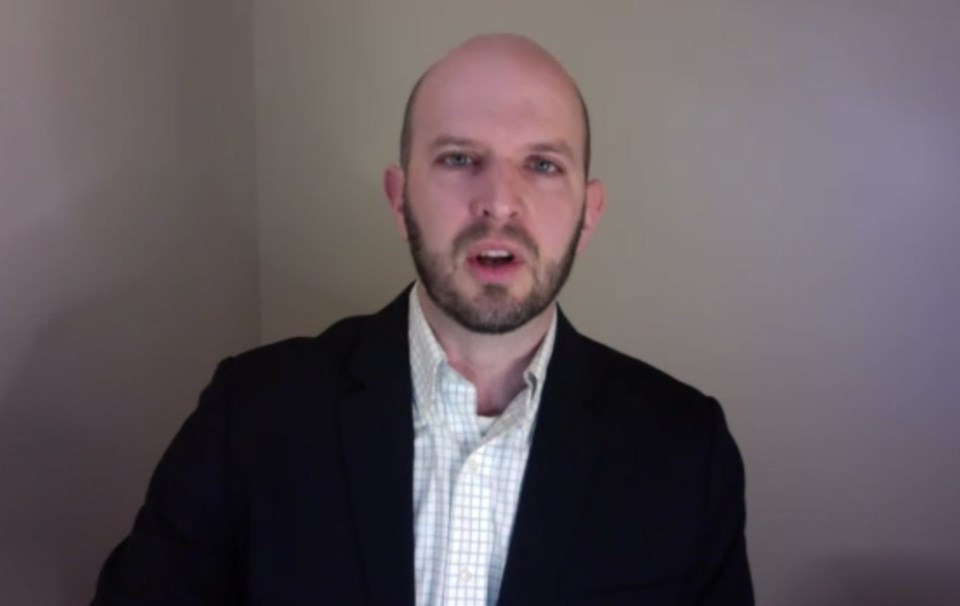Saskatoon– New Democratic Party (NDP) Leader Ryan Meili responded on Nov. 20 to new COVID-19 modelling released by the Saskatchewan Ministry of Health the day before, after calling for new modelling for much of the fall.
Speaking via a Zoom video conference from Saskatoon, Meili said it “shows a very disturbing path ahead, when we look at the potential number of new cases, of hospitalizations and of deaths here in Saskatchewan.”
“That's going to be causing a lot of worry and concern for families for small businesses and workers who are wondering what this is going to mean for their jobs.” He said people across the province are worried about their own health, the economy, and “what that impact will be if we go down the road of Manitoba, Alberta and North Dakota, which the modeling suggests could happen here.”
Each of those jurisdictions is showing exponential growth of new cases of COVID-19, and are currently dealing with higher new cases per day.
He noted “great concern” for seniors, and called on the province to increase staffing for long-term care homes.
Meili and NDP Seniors Critic, Saskatoon Eastview MLA Matt Love, noted many workers at long-term care homes work there part-time, and have to either worth at multiple facilities, or at other part-time jobs. Since cohorting has limited their ability to work at multiple locations, he said they should be brought on as full time staff, as a way of “staffing up” the system.
Similar measures should be taken for nurses who are currently working casual hours, less than full-time.
“That’s exactly the problem. We need to staff up, to the ability we’re able, to get everyone on board that we can,” Meili said. “Waiting for the health care system to respond to this, switching to this idea that we’re just going to let this go wild in the community, and then deal with it in healthcare, is so dangerous, because you’re right, the staff’s just not there.”
Love said there are a lot of casual workers. “Part of staffing up is moving them to full-time hours.”
Love said the province should use money from the $160 million COVID-19 contingency fund specifically for staffing up long-term care and home care, “to make sure seniors are able to stay in their homes, safely, for as long as possible.”
He also called for “regular and clear communication from the government on pandemic outbreaks. We want to see steps taken to mitigate those outbreaks.”
Love also said there should be an independent review into long-term care in Saskatchewan.
“We're calling for an emergency protocol to be put in place to guarantee minimum standards of care, with the appropriate resident-to-caregiver ratios. We're calling for minimum hours of daily care for each resident in long-term care and reduction to the number of residents per room.”
Love also said the government should increase access to technology for seniors to address mental health needs.
Meili stressed the need to take preventative measures, saying, “If the virus gets as bad as what the modeling is suggesting it will and, no, we won't have the staff to deal with it. And then you've got a situation where we're seeing people triaged in their car in Steinbach, Manitoba, and we're going to be dealing with things like that people triage in their cars, people being refused care because there just isn't any, and doctors having to make the kind of decisions that none of us want.”
The modelling released by Saskatchewan on Nov. 19 and the federal government on Nov. 20 both show hockey-stick shaped graphs, with new cases of COVID-19 modelled to climb rapidly in the next few weeks. Of the four new scenarios modelling Saskatchewan, three of them suggest that in six months, between 300,000 to 469,000 people in Saskatchewan could become infected, or 25.6 to 40 per cent of the province’s population. The remaining “optimistic” scenario has already been surpassed.
Asked about this, Meili said, “These are deeply concerning numbers, and we see that the trajectory we’re on, the current state, the state that health care leaders and providers are planning on, is of thousands more cases, hundreds more deaths, hundreds of hospitalizations per day.
“We're talking about a health care system that's already overburdened, being completely overwhelmed. And this is why it is so frustrating to see the government doubling down on limited action, when this is the time, this is the time to bring in that three-weeks circuit breaker, to really change that course.
“We saw the optimistic scenario, but right now with the measures in place, that's really a faint hope scenario, it's not going to happen. And we're going to see the type of exponential growth that the modeling shows here and around Canada. There are things we can do. Do them now. Do not wait two weeks to see if doing what we know is inadequate. That's the wrong approach. We need the minister, we need the premier, to step up and show leadership, otherwise we are going to be dealing with very dire circumstances and loss of life, sickness and terrible damage for economy. Thousands of people, more out of work than need to be.”
The NDP have been calling for a three-week “circuit breaker,” a “temporary adjustment of severe actions, now, short term, so that we get things under control.”
Meili said the Saskatchewan Party government “knew this was coming, decided to run an election based on the idea that everything was over and that we'd already beat this.” As a result, he said Saskatchewan is now behind.
Manitoba has implemented a lockdown where stores are only allowed to sell essential goods, and visiting private homes is not allowed.
Meili said, “In the spring, this was new to everybody. But we’ve had eight months, and Scott Moe was acting like it was done, and sat on his hands, instead of working to make sure we didn’t see what we’re about to see, here in Saskatchewan.”



